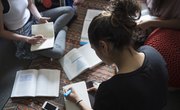Annotating a text may seem like unnecessary work at first. If you’re just starting out in the world of text analysis, annotating a text may seem like a sneaky way your teacher is making you show that you’ve read the assignment. But annotation has benefits for you as a reader, too. By interacting with the text, you'll not only remember more of what you've read, but it also makes it easier for you to go back and write about the text without having to reread the whole thing.
Annotating a text helps you see patterns and make connections. Annotated notes can also help you study by making your own notes clearer and more visually striking.
Supplies for Annotating a Text
To make annotated notes or any other kind of annotation, you'll need writing devices with ink or fluid that will stand out on your page. Highlighters are a staple of text annotation, but you can’t annotate an example text with highlighters alone. Make sure you have something bolder, like a dark ink pen, so the notes you write in the margins are clear and legible.
Techniques for Annotated Notes
For annotated notes, your goal is to make them visually appealing and easy to study. Start with notes you took during a lecture and compare them with other materials, such as textbook pages given to you by your teacher.
Annotation example: For a biology class, you might find the list of keywords given at the beginning of the chapter you’re studying. Using a highlighter, locate all of the keywords in your own notes. If you don’t remember the definition of one, write it in the margin with your pen.
Techniques for Annotating a Text
Different types of texts call for different kinds of annotation. Some of these kinds can be remembered with a mnemonic device. One type of mnemonic device that you can use is called DIFS. DIFS stands for Diction, Imagery, Figurative Language and Syntax. When annotating using DIFS, you'll need four different colors of highlighter (one for each letter in DIFS) and a pen to write notes in the margins.
Practicing With an Example Text
In the short example text from "The Great Gatsby," F. Scott Fitzgerald uses several literary devices. You can practice locating and labeling them using DIFS.
"And so with the sunshine and the great bursts of leaves growing on the trees, just as things grow in fast movies, I had that familiar conviction that life was beginning over again with the summer."
In this example text, you might highlight the words “familiar conviction” for having unusual diction. “Sunshine” and “great bursts of leaves” are examples of imagery. Beginning a sentence with “And” is a nontraditional syntactical choice, and “life was beginning over again” is figurative language.
Related Articles
References
Writer Bio
Rebecca Renner is a teacher and college professor from Florida. She loves teaching about literature, and she writes about books for Book Riot, Real Simple, Electric Literature and more.











